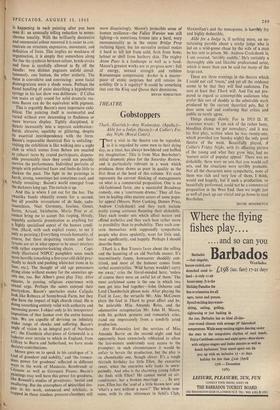ART
Behind the Pulpit
rr HE two exhibitions at the Marlborough New 1 London Gallery should not be missed. Bacon is showing a group of entirely recent work: Moore's sculpture covers the period 1950-64 and provides as centre-pieces six major bronzes. In the catalogue Moore refers to Giovanni Pisan° . . you can really see what a great sculptor and human being he was. His figures are static and dynamic at the same time, and they make you see that the pelvis can move in an opposite direction from the thorax, and that the neck is not just an extension of the body, and so on.' These comments apply to Bacon: his figures are static and dynamic in the way that movement, momen- tary distortion, the sensation of an after-image, or the vertiginous swirl of an elliptically curved room is accentuated by the flow of movement coursing through its three isolated occupants. All this is dynamic, but the use of colour and the varied manipulation of paint exist so strongly and inde- pendently in their own right that movement is checked by the sheer force of their presence. They clamour for separate attention like a firework display and make the comparative obscurity of certain details seem irrelevant. Similarly the ring and spatial structure in the painting of two figures after Muybridge is three-dimensional : but space is at once implied and disrupted in the face of the absolute flatness of colour which contradicts these allusions to perspective. Again, if the colour is flat on one plane, it works tonally in sonic strange way, for the black-and-white illustrations in the catalogue tell you a great deal about what
is happening in each painting after you have seen it: an unusually telling reduction to mono- chrome tonality. With the brilliantly decorative and ceremonial colour removed it is easier to con- centrate on structure, expression, movement, and definition of form. This implies no weakness of organisation, it is simply that somewhere along the line the synthesis between colour, brush-stroke and form is carefully allowed to fly off the handle: two distinct pageants unfold simul- taneously, one human, the other aesthetic. The form is convulsive and convincing: some facial
disintegrations seem a shade vouin. Perhaps the
banal handling of paint describing a hypodermic syringe in his last show was deliberate: if Callas can make an ugly sound for solid dramatic rea- sons Bacon can do the equivalent with pigment.
This is arguably Bacon's most impressive exhi- bition. The painting itself is resourceful and varied without ever descending to flashiness or mere bravura display. Tightly disciplined, it thrusts incessantly into a separate celebration : harsh, abrasive, squelchy or glittering, despite its essential interdependence with the form. Bacon's impeccable theatrical flair is unfailing : visiting the exhibition is like walking into a night club in which scenes from Belsen are enacted as cabaret turns by crazed participants, dispens- able presumably since they could not possibly survive the performance. Individual portraits of People with pulverised faces and limbs do little to slacken the pace. The light in the paintings is harsh, strong, sometimes hot sometimes cool, and totally revealing : Bacon's world emerged from the darkness long ago. The curtain is up.
And this is where I cut out for the bar. The swastika bands objectify events• for a second, but all possible invocations of de Sade, sado- masochism, Nazi Germany, fascism, Genet, Sartre, Artaud, Swinburne, Mario Praz et al. cannot bring me to accept this rasping, bloody, superbly authentic presentation as anything but a highly specialised aspect of the human condi- tion. (Hard, with such explicit events, to see it only as painting.) Everything reveals humanity, of course, but these despairing victims and their tyrants are set in what appear to be smart interiors With rather expensive-looking chairs. . . . Copi- ously illustrated NSPCC pamphlets seem much more horrific (smashing a five-year-old child prac- tically to death and pushing white-hot irons in its face, etc.), The thought of old age pensioners dying alone without money for the amenities up- sets me, too. But Albee's great play Tiny Alice equates, in passing, religious experience with sexual urge. Perhaps the saints enjoyed their Martyrdom. Bacon's spectacles make Caligula look like Rebecca of Sunnybrook Farm, but they also have the impact of high church ritual. He is doing something entirely valid with authority and increasing power. I object only to his interpreters' imposition of that licence over• the entire human race. We are capable of devising an infinitely Wider range of shocks and suffering. Bacon's angle of vision is an integral part of Northern art : the Eisenheiii altar-piece of Grfinwald is a lodestar over terrain to which in England, from Gillray to Burra and Sutherland, we have made decisive contributions.
Moore•goes on to speak in his catalogue of `a kind of grandeur and nobility,' and `the tremen- dous power for goodness' reflected in different ways in the work of Masaccio, Rembrandt or Cezanne as well as Giovanni Pisano. Bacon's Paintings may well have this power for goodness, like Rouault's studies of prostitutes: bestial and unalluring. But the atmosphere of objectified des- Pair in his work, entranced and nihilistic, is trapped in those timeless pressure-chambers still
more disquietingly. Moore's invincible sense of human resilience—the Fallen Warrior was still fighting—is sometimes frozen into a hard, wary monumentality as in the recent Bridge Prop reclining figure, but his surrealist instinct makes it hard to tell hot from cold, flesh from bone, helmet or shell from leathery skin. The mighty Atom Piece is a landscape as well as a head. Moore's greatest works are in progress now : full of energy, sensual strength and ruthless Romanesque compression. Archer is a master- piece of erotic surprises but still retains its nobility. Or is it regality? It could be something that cost the King and Queen their dominions.
BRYAN ROBERTSON































 Previous page
Previous page